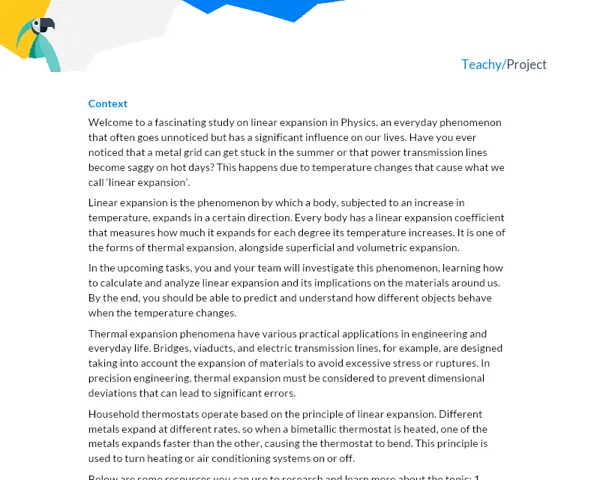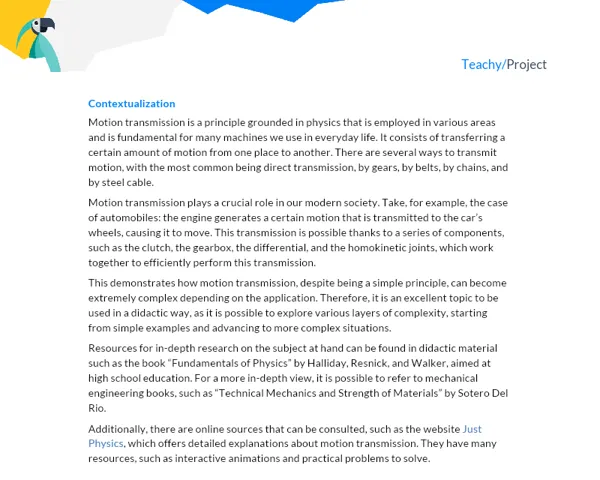Contextualization
Studying the speed of waves in strings is notably one of the most fundamental and fascinating aspects of Physics. The propagation speed of a wave in a string varies depending on a series of factors, and having a solid understanding of these variables is crucial for a diverse range of applications, from simple musical instruments to highly complex fiber optic communication systems.
This phenomenon is observed when a pulse is generated at one end of the string and propagates throughout its length. The propagation speed of these pulses, or waves, is mainly influenced by the linear density of the string and the tension applied to it. This is the theoretical basis on which this project will be founded: the speed of a wave in a string is given by v = sqrt(T/µ), where v is the wave speed, T is the tension applied to the string, and µ is the linear density of the string.
In our daily lives, this principle applies in various situations. String musical instruments are an excellent example. The tension applied to their strings by the musician affects the speed of the wave that generates the sound of the instrument. Different tensions produce distinct musical notes. Additionally, fiber optic communication systems are also based on wave propagation. Therefore, understanding this principle can elucidate how information travels almost instantaneously from one side of the planet to the other.
To carry out the project, we recommend the following resources as a basis:
- Fundamentals of Physics, Volume 2: Gravitation, Waves, and Thermodynamics - Halliday & Resnick.
- Waves and Music
- Use of optical fibers in data transmission
Practical Activity
Activity Title: Unraveling the Speed of Waves in Strings
Project Objective
- Understand and calculate the speed of waves in strings with different materials and under different tensions.
- Apply the knowledge obtained to explain the functioning of string musical instruments and data transmission through fiber optics.
Detailed Project Description
This project is an experiment that involves creating a simple model of a string where waves are generated. Students will study the propagation speed of these waves in strings made of different materials and under different tensions. Then, they will apply this knowledge to the real world, explaining how string musical instruments and data transmission in fiber optics work.
This is a group project and should be carried out in groups of 3 to 5 students. The estimated duration for the execution of this activity is about 15 hours, distributed over several sessions.
Required Materials
- Various types of strings, with different densities and diameters (e.g., nylon, steel, cotton, etc.).
- Precise scale.
- Ruler or measuring tape.
- Means to apply and vary the tension in the strings (e.g., attachment with variable weights).
- Smartphone with high-speed camera or a camera capable of recording slow-motion video.
- Video analysis software or application (there are free options available online).
Detailed Step-by-Step for Carrying Out the Activity
- Preparation: For each type of string, students should measure the length, mass, and calculate the linear density (µ = mass/length).
- Experiment Execution:
- Fix one end of the string and apply tension to the other end using weights. Record the applied tension.
- Generate a wave in the string by pulling and releasing it, and film the process with the camera in slow motion.
- Use the video analysis software to measure the time it takes for the wave to travel a certain length of the string.
- Calculate the wave speed (Speed = Distance/Time).
- Repeat the steps for different tensions on the same string and for different types of strings.
- Analysis and Discussion: Discuss the results obtained, compare the wave speeds in different strings and under different tensions. Are the results consistent with the formula v = sqrt(T/µ)?
- Real-World Application: Based on the experiment results and considering the characteristics of musical instruments and fiber optics, discuss how these devices work. Relate it to what was learned in the experimental part of the project.
Project Deliverables
Students must prepare a report documenting the entire project. The report should include:
- Introduction: An outline of the project, including the objective, a basic explanation of the physical concepts involved (e.g., waves, linear density, tension), and the relevance of this study.
- Development: Detailed description of the practical activity, including the method used, the materials, and the steps followed in conducting the experiment. It should also contain the presentation and discussion of the results. This section is the longest and should demonstrate how the fundamental concepts were applied in practice.
- Conclusion: Recap of the main points of the project, explanation of the learnings obtained (including socioemotional ones), and conclusions about the study of wave speed in strings and its real-world applications.
- Bibliography: References to the resources used to learn the concepts and carry out the project.
Remember, documentation is an important part of the project. It should be clear and comprehensive, explaining not only the results but also how they were obtained.


